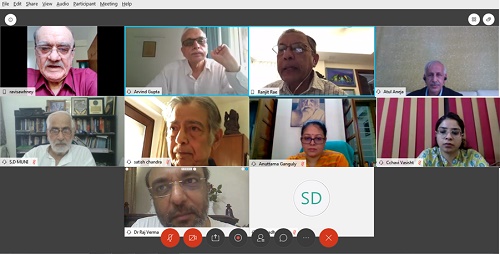On 09 July 2020, the Vivekananda International Foundation (VIF) hosted an online discussion on “India, China and South Asian Neighbours”. Dr Arvind Gupta delivered the opening remarks followed by presentations by Dr Raj Verma and Dr Atul Aneja. From the VIF, Amb Ranjit Rae, Gen Ravi Sawhney, Amb Satish Chandra, Prof S.D Muni and Dr Sreeradha Datta participated in the event.
Dr Gupta outlined China’s inroads into the South Asia region over the years. China’s influence in the neighbouring countries needs to be studied, such as the China-Pakistan Economic Corridor (CPEC) and its presence in the Gilgit-Baltistan region. In Nepal, Chinese Ambassador’s increasing interference in Nepal’s internal politics, which to a certain extent has complicated matters between India and Nepal. In Sri Lanka, the Hambantota Port project has created massive debt for the country. In Myanmar, China has a strong influence on the on-going peace processes in the country and the two countries share close economic relationship. The economic relationship between the China-Bangladesh is growing with 25 million worth projects underway. China asserts its territorial claim in the South Asian neighbourhood such as in Bhutan. The Chinese activities in the Indian Ocean region depict its growing interference in the region. The latest incident in the Galwan Valley makes it imperative to discuss the larger Sino-India issues. There is a need for India to revisit its policies towards China as well as the South Asian Neighbourhood.
In the 20th century, China’s geo-political, geo-economic and geo-strategic interests drove its engagements in South Asia. In 2008, China adopted the policy of “Good Neighbourhood Relations” - in which it aimed to develop economic relations with its neighbouring countries. The Chinese extension in the South Asian neighbourhood increased since November 2012, after Xi Jinping assumed national leadership in China. In 2014, China started working for the new Asian Security concept, which meant establishing itself as a predominant power in Asia and upped its ante in the South Asia. China considers the socio-political and economic stability of South Asia essential for its growth and stability.

However, historically, the South Asia subcontinent is bonded together with the cultural affinities. India has a central role in the region, which continues in the 21st century. The South Asian region and the India Ocean region is India’s area of interests and India needs to push ahead in South Asia with its collaborations. The recent push back against growing Chinese investments and indebtedness in the neighbourhood is affecting China’s influence. The bankruptcy in Maldives, Pakistan and Sri Lanka are going to create problems but will work in favour of India. However, the experts also cautioned that the backlash to Chinese projects should not be comforting for India as in the case of Sri Lanka where the Chinese lease agreement does not appear to be worrisome to that country.
Unfortunately, a sense of alienation has appeared between India and its neighbours, and China has exploited this situation. India has identified with the neglected sections in the neighbourhood such as the Terai population in Nepal, and Tamil diaspora in Sri Lanka, which has created nationalist strain in the respective countries. India must explore new constituencies and develop comprehensive national strength to bridge the gap between strategic, political and economic integration. India must ‘Reorient, Revisit and Redefine’ its diplomatic culture and change the perception in the South Asian Neighbourhood.
India needs to incorporate big mega projects in the neighbourhood. So far, India has focussed on small projects, such as housing project in Sri Lanka and pipeline projects in Nepal. India’s exports are not adequate and its economy is not deeply integrated with the South Asian region. India must also focus on how to strengthen democracy and further the role of the Indian civil societies to strengthen bonds within South Asia. The discussion suggested that India must dig deep into its civilisational roots, and become conscious of its geo-cultural influence. Extending these cultural relations from South Asia to South East Asia, India could counter China by exercising its ‘civilizational strategic autonomy’.
India must also reach out to its partners in a systematic manner, economically and militarily, and enhance strategic autonomy. For instance, by projecting the QUAD+ (Plus) being joined by Vietnam, Brazil, South Korea and many others. With financial and technological support from Japan and the United States, India could counter China in the Indo-Pacific. Partnership with Russia could help India thwart China in Central Asia. India could also collaborate with Japan, as India needs Japanese expertise and deep pockets.
The discussion concluded that even though currently the situation might be of disengagement, but India must continue looking for potential options, such as building alliances-economically and militarily, joint ventures and collaborations. India has problems in coordination; for instance, the Asia-Africa Growth Corridor with Japan could not be successfully implemented due to unknown factors. And, India has weaknesses in the implementation of big projects; the aim should be to speed up the planning and implementation of soft and small projects, which is India’s strength. Efforts should be made to formulate the database and then strategize and coordinate to reach out to the societies in the neighbourhood. The civilizational connect between the South Asian countries are years old and therefore India must take proactive steps in building these connect further. For example, the tourism circuits should be established and scholarships must be given to encourage people-to-people ties. India must act swiftly and strategically to counter Chinese presence in the neighbourhood.

_0.jpg)






Post new comment